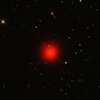Low Mass Stars
Astronomy & Cosmology -
Stars - Life & Death of Stars
These are stars with masses less than about 40% of the mass of the Sun. There is no firm lower limit, but it is generally set at about 13 times the mass of the planet Jupiter or about 1.2% of a solar mass.
Brown Dwarf Stars
These are objects weighing between 13 and 80 times the mass of Jupiter; that is, between about 1.2% and 8% of the Sun's mass. The term has been in use only since 1975 when it was coined to differentiate between these stars, which had been theorized but not observed, and the hypothetical remnants of Sun-sized stars which are called Black Dwarfs. The first Brown Dwarf star was not found until 1988, although this star was on the border between Brown Dwarf and a very low mass conventional star. The first confirmed true Brown Dwarf, Teide 1, was documented in 1995. To the right the image shows Gliese 229, a Red Dwarf, with its tiny companion, Gliese 229B, which is the second Brown Dwarf found, being slightly smaller and cooler than Teide 1. It has now cooled to the point where methane is evident in its atmosphere, which would never occur in a conventional star. There are now a great many identified, most of which were found by the Wide-field Infrared Survey Explorer (WISE) satellite. One of these is WISE 1828+2650, which is one of the coolest known having a surface temperature between 250 and 400 K (-23 & 127°C or -10 & 260°F).
They do not manage to get to the point of being hot enough to fuse hydrogen into helium, but may initiate Deuterium fusion a process by which a deuterium nucleus and a proton combine to form a helium-3 nucleus. Because of the limited amount of deuterium available, this process lasts only for around 10 to 100 million years or so. They only get to a temperature of about 3,500ºK, which means that they glow a dull red color. Once any deuterium has been used up, the dwarf radiates its heat energy and gradually cools over a period of, perhaps, 100 million years until it is no longer radiating in the visible spectrum but mainly in the infrared. Eventually the temperature drops to the prevailing temperature of space.
Though substantially heavier than Jupiter, Brown Dwarfs are generally about the same size as Jupiter, or a little larger. Differentiation between gas giant planet and Brown Dwarf is based on density and, therefore, mass.
Brown dwarfs are sometimes split into three categories based on their temperatures:
- The coolest are the "Y Dwarfs" with temperatures between 250K and 500K. 300K is about 27C or 80F.
- Next up the "T Dwarfs" are between 500K and 1,500K. 1,250K is about 977C or 1,790F.
- Finally, the "L Dwarfs" are between 1,500K and 3,000K. 2,500K is about 2,227C or 4,040F.
Red Dwarf Stars
Objects with between about 8% and 40% of the sun's mass are red dwarf stars. They are likely to sit on the main sequence, quietly burning hydrogen, for twenty billion years or more, and then take several more billion years to die. Having no radiation layer, like their larger brethren, they rely on a convection process that is very efficient in converting pretty much all the stars hydrogen into helium. The star shrinks, but cannot produce the temperatures required to support the next stage of fusion; that is, burning the helium. It shrinks further becoming hotter and denser and, eventually, it will become a small white dwarf. Unlike somewhat heavier stars like the Sun, these small stars do not go through a red giant phase. None has had time to become a white dwarf yet; the Universe is not old enough! Barnard's Star, an intermediate population II red dwarf about six light years from the Earth, weighs about 15% of the Sun and is somewhere around 7 to 12 billion years old. It is probably about half way through burning its hydrogen before becoming a small white dwarf and then cooling for several hundred billion years to become a black dwarf.
The upper image on the right is Proxima Centauri, a typical red dwarf that is about 4.24 light-years away, making it the closest star to us, after the Sun, of course! It has a diameter about 1/7th that of the Sun, and a mass about 1/8th of the Sun. It is the third star of the Alpha Centauri system. It has one confirmed planet, Proxima Centauri b, In addition, Proxima Centauri d is a candidate planet while Proxima Centauri c is disputed.
The lower image on the right is Ross 128, another red dwarf that is about 11 light-years away, making it the 12th closest star to us. It has a diameter about 1/5th that of the Sun, and a mass about 18% of the Sun. Interestingly, Ross 128 and the Sun are drawing closer to eachother, and in about 71,000 years they will make their closest approach and be only about 6 and a quarter light-years apart. It has one confirmed planet, Ross 128 b.




